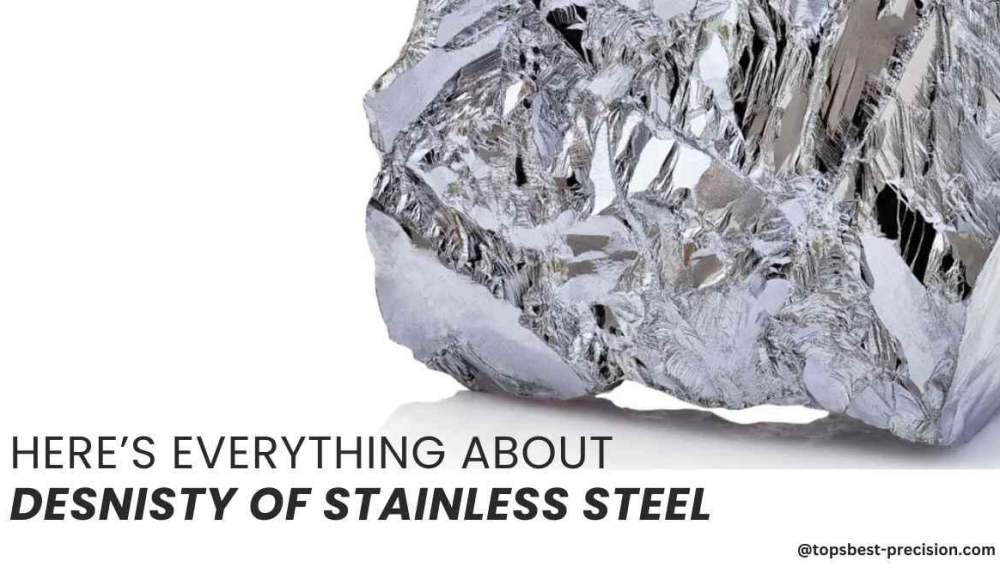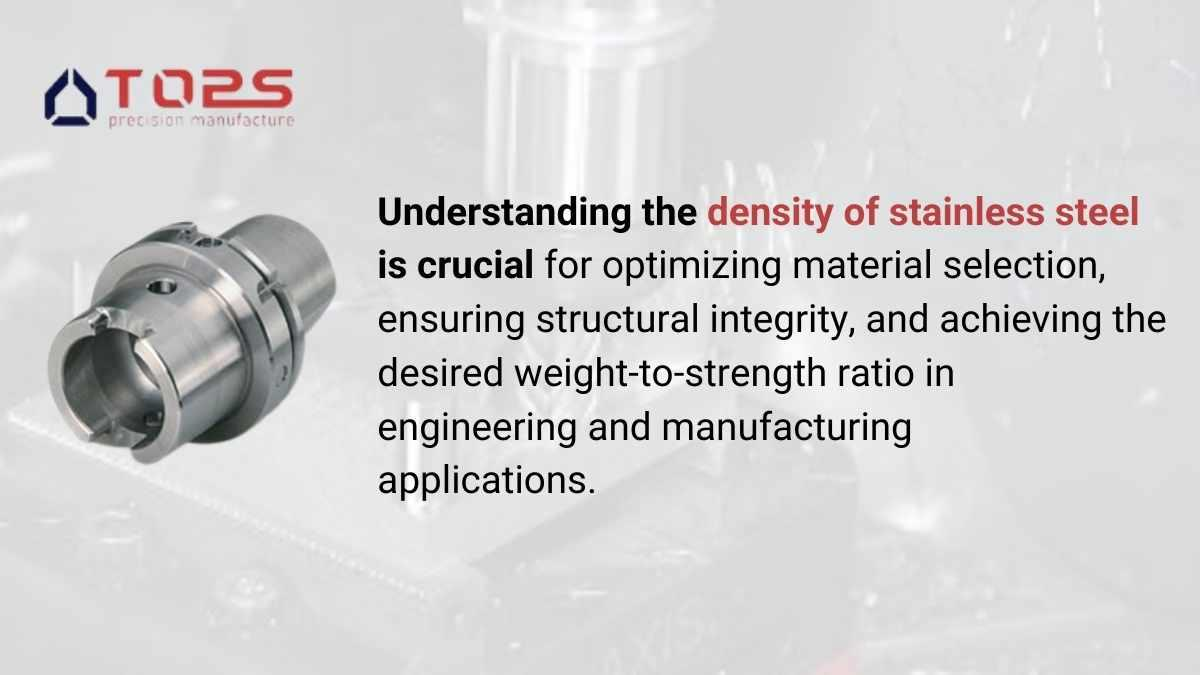Density is perhaps the single most critical factor to consider when deciding material type to use in your projects. One of the most common and reliable types of steel is stainless steel which is mainly appreciated by the aerospace industry and construction companies. But how does the density of the SS affect your decisions and actions? Knowledge of density is crucial when it comes to the determination of the weight strength and performance in a certain project. This guide will give you all the information that you require for designing and manufacturing stainless steel.
What is the Density of Stainless Steel?
The density of stainless steel falls between 7.75 to 8.05 g/cm³ (grams per cubic centimeter) depending on the grade. It is almost equal to the density of carbon steel and other metals like aluminum but less than that of heavy metals like lead. The density fluctuation is attributed to the consumption of chromium, nickel, and even other alloys within different kinds of stainless steel grades. The typical density confers the strength and the stainless steel weight. For such reason, its use is common where strength under pressure, resistance to corrosion, and durability are desired. The density and tensile strength of the steel are generally increased as the nickel content is increased.
Stainless Steel Density Table
The density of stainless steel can vary depending on the alloy and composition. Here’s a table showing the approximate density values for various common types of stainless steel:
| Stainless Steel Grade | Density (g/cm³) | (kg/m³) | (lb/in³) |
| 304 (Austenitic) | 7.93 | 7930 | 0.286 |
| 316 (Austenitic) | 7.98 | 7980 | 0.288 |
| 430 (Ferritic) | 7.75 | 7750 | 0.280 |
| 410 (Martensitic) | 7.70 | 7700 | 0.279 |
| 2205 (Duplex) | 7.80 | 7800 | 0.283 |
| 440C (Martensitic) | 7.75 | 7750 | 0.280 |
| 17-4 PH (Precipitation Hardening) | 7.80 | 7800 | 0.283 |
How Does Density Influence the Role of Stainless Steel?
Density understanding is of paramount importance as it relates to the weight and strength of the material as well as its use in different applications. Here’s why it matters:
1. Impact on Weight and Strength
Thick Density areas mean there are more materials to be used within the volume and this leads to a heavier part. In structural applications for example in aerospace and construction, a material’s weight may determine the load and the structure it must support. Regarding strength, tough alloys are denser. Therefore, they possess higher tensile strength pressure and stress-bearing capability. So, austenitic stainless steels (like 304 and 316) are mostly applicable to high-strength, and stress applications.
2. Material Selection for the Particular Application
Understanding density of the the stainless steel makes it easy to determine the certain grade optimum for a particular application. For example:
- Ferritic stainless steel, for instance, 430, has a low density and is usually appreciated when light material is desirable. For example, for household use or car parts.
- A higher density grade of stainless steel, such as 316 and Duplex 2205 is used where weight matters, as in the case of a marine or chemical processing application.
3. Thermal Conductivity Coupled with Heat Resistance
Density is also identified as thermal conductivity, as well as thermal resistance. In many heat exchange systems where heat has to be transferred at high temperatures, the alloys with higher density are known to have better heat retaining characteristics. On the other side, the material having low density will lose heat more frequently. Thus, SS is majorly beneficial for cooking vessels and heat protection shields.
4. Manufacturing and Processing
Density influences how the material behaves during various machining and fabrication steps. Thicker materials are generally harder to bend to shape, cut, and weld than thin ones. Hence they may need sophisticated machinery and processes. It also determines the facility with which the material can be formed especially on, complex shapes.
What is the Density of 304 Stainless Steel?
The density of 304 stainless steel is about 7.93 g/cm³, or 7930 kg/m³, or 0.286 lb/in³. 304 stainless steel belongs to the austenitic family. It is widely used for its corrosion resistance, formability, and strength. These properties make it suitable for kitchen equipment, medical devices, tile trims, stanchion posts and many other applications.
What is the Density of 304 Stainless Steel in lb/in3?
The density of 304 stainless steel is 0.286 lb/in³ or 7.92 kg/dm³ (kilograms per decimeter). The value is based on the standard density of 304 stainless steel, which is 7.93 g/cm³ or 7930 kg/m³, which has been converted into lbs/in³. The following density makes 304 stainless steel relatively dense and strong. Predominantly, the applications of 304 stainless steel include; kitchen utensils and machines.
What is the Density of Stainless Steel Grade 316?
The density of stainless steel grade 316 is about 0.288 lb per cubic inch, 7.98 grams per cubic centimeter, and 7980 kilograms per cubic meter. Stainless steel grade 316 is an austenitic product. Therefore, it can perform well in chloride-containing environments such as marine, chemical industry, and medical settings. The intended density results in high strength, durability, and high corrosion resistance.
What is the Density of Stainless Steel 316 in kg/m3?
The density of stainless steel grade 316 is around 0.07988 g/cm³ or 7980 kg/m³ or 0.000158 lb/ft³ (0.493 lbm/ft³). The nominal density is characteristic of 316 stainless steel, (an austenitic type of steel). It has a high corrosion resistance, particularly in the marine and chemical industry, and is usually less likely to be affected by stress.
Which is Heavier Mild Steel or Stainless Steel?
Stainless steel is usually more massive than mild steel.
Here’s why:
- Carbon steel(mild steel) commonly has a density of approximately 7,850 kg/m³, 7850 kg/m³, or 0.284 lb/in³.
- Stainless steel for example 304 or 316 has a density ranging from 7.75 g/cm³ to 8.05 g/cm³ (7750–8050 kg/m³ or 0.280 – 0.292 lb/in³).
- Even though both materials are generally of similar density. Stainless steel is on average marginally denser than mild steel especially because of the nickel, chromium, and at times molybdenum alloying constituents. Therefore, for the same material volumes, stainless steel is somewhat heavier than mild steel.
Nevertheless, the weight change is rather small. Although, it can be crucial in specific applications where weight is typically a top priority such as aerospace, and automotive applications.
Why Knowing the Density of Stainless Steel Matters?
Density has a direct bearing on the material strength to be used for constructing buildings. For instance, true flat stainless steels have higher tensile strength than leaner ones. This makes it ideal for rigid dispensing applications. These applications are frequently subjected to pressure or stress. Thicker alloys hold heat longer which is important in heat exchangers or cooking equipment.
Moreover, density is useful in the manufacturing processes. For instance: thicker materials may call for greater energy and highly fabricated instruments when fiber laser cutting, welding, or otherwise affecting the sizes of the material in use; this will take time and money. Finally, density is central for decision-making serials. For instance, thin-gauge ferrous content products, such as type 430, are selected where lightweight is desirable while heavier types (316) are preferred for their strength and corrosion resistance. In short, the density helps determine the right performance, fabrication, and material cost in question.
Summary
In summary, density knowledge is significant for choosing the right grade to exploit in different situations. It influences weight, strength, and thermal characteristics, and is typically involved in the aerospace, automobile, and construction industries. Furthermore, density helps in selecting materials for stress, pressure, and temperature requirements, as well as choosing efficient manufacturing and fabrication methods. At Tops Precision, we appreciate the impact of these critical factors while offering you materials with high performance to fulfill your CNC machining project needs.





1 thought on “Here’s Everything About the Density of Stainless Steel”